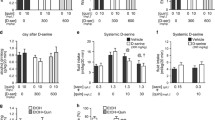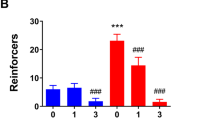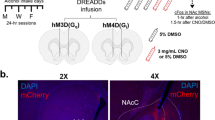Abstract
Rationale
The development and progression of alcohol use disorder (AUD) are widely viewed as maladaptive neuroplasticity. The transmembrane alpha-amino-3-hydroxy-5-methyl-4-isoxazole propionic acid receptor (AMPAR) regulatory protein γ8 (TARP γ-8) is a molecular mechanism of neuroplasticity that has not been evaluated in AUD or other addictions.
Objective
To address this gap in knowledge, we evaluated the mechanistic role of TARP γ-8 bound AMPAR activity in the basolateral amygdala (BLA) and ventral hippocampus (vHPC) in the positive reinforcing effects of alcohol, which drive repetitive alcohol use throughout the course of AUD, in male C57BL/6 J mice. These brain regions were selected because they exhibit high levels of TARP γ-8 expression and send glutamate projections to the nucleus accumbens (NAc), which is a key nucleus in the brain reward pathway.
Methods and results
Site-specific pharmacological inhibition of AMPARs bound to TARP γ-8 in the BLA via bilateral infusion of the selective negative modulator JNJ-55511118 (0–2 µg/µl/side) significantly decreased operant alcohol self-administration with no effect on sucrose self-administration in behavior-matched controls. Temporal analysis showed that reductions in alcohol-reinforced response rate occurred > 25 min after the onset of responding, consistent with a blunting of the positive reinforcing effects of alcohol in the absence of nonspecific behavioral effects. In contrast, inhibition of TARP γ-8 bound AMPARs in the vHPC selectively decreased sucrose self-administration with no effect on alcohol.
Conclusions
This study reveals a novel brain region-specific role of TARP γ-8 bound AMPARs as a molecular mechanism of the positive reinforcing effects of alcohol and non-drug rewards.




Similar content being viewed by others
Data availability
Data from this study are available from the corresponding author upon reasonable request.
References
Agoglia AE, Holstein SE, Eastman VR, Hodge CW (2016) Cannabinoid CB1 receptor inhibition blunts adolescent-typical increased binge alcohol and sucrose consumption in male C57BL/6J mice. Pharmacol Biochem Behav 143:11–17
Agoglia AE, Holstein SE, Reid G, Hodge CW (2015a) CaMKIIalpha-GluA1 activity underlies vulnerability to adolescent binge alcohol drinking. Alcohol Clin Exp Res 39:1680–1690
Agoglia AE, Sharko AC, Psilos KE, Holstein SE, Reid GT, Hodge CW (2015b) Alcohol alters the activation of ERK1/2, a functional regulator of binge alcohol drinking in adult C57BL/6J mice. Alcohol Clin Exp Res 39:463–475
Bats C, Farrant M, Cull-Candy SG (2013) A role of TARPs in the expression and plasticity of calcium-permeable AMPARs: evidence from cerebellar neurons and glia. Neuropharmacology 74:76–85
Besheer J, Fisher KR, Cannady R, Grondin JJ, Hodge CW (2012) Intra-amygdala inhibition of ERK(1/2) potentiates the discriminative stimulus effects of alcohol. Behav Brain Res 228:398–405
Besheer J, Lepoutre V, Mole B, Hodge CW (2006) GABAA receptor regulation of voluntary ethanol drinking requires PKCepsilon. Synapse 60:411–419
Bissen D, Foss F, Acker-Palmer A (2019) AMPA receptors and their minions: auxiliary proteins in AMPA receptor trafficking. Cell Mol Life Sci 76:2133–2169
Cannady R, Fisher KR, Durant B, Besheer J, Hodge CW (2013) Enhanced AMPA receptor activity increases operant alcohol self-administration and cue-induced reinstatement. Addict Biol 18:54–65
Cannady R, Fisher KR, Graham C, Crayle J, Besheer J, Hodge CW (2016) Potentiation of amygdala AMPA receptor activity selectively promotes escalated alcohol self-administration in a CaMKII-dependent manner. Addict Biol 22:652–664
Conrad KL, Tseng KY, Uejima JL, Reimers JM, Heng LJ, Shaham Y, Marinelli M, Wolf ME (2008) Formation of accumbens GluR2-lacking AMPA receptors mediates incubation of cocaine craving. Nature 454:118–121
Edeline JM, Hars B, Hennevin E, Cotillon N (2002) Muscimol diffusion after intracerebral microinjections: a reevaluation based on electrophysiological and autoradiographic quantifications. Neurobiol Learn Mem 78:100–124
Ewin SE, Morgan JW, Niere F, McMullen NP, Barth SH, Almonte AG, Raab-Graham KF, Weiner JL (2019) Chronic intermittent ethanol exposure selectively increases synaptic excitability in the ventral domain of the rat hippocampus. Neuroscience 398:144–157
Faccidomo S, Besheer J, Stanford PC, Hodge CW (2009) Increased operant responding for ethanol in male C57BL/6J mice: specific regulation by the ERK1/2, but not JNK, MAP kinase pathway. Psychopharmacology 204:135–147
Faccidomo S, Cogan ES, Hon OJ, Hoffman JL, Saunders BL, Eastman VR, Kim M, Taylor SM, McElligott ZA, Hodge CW (2021) Calcium-permeable AMPA receptor activity and GluA1 trafficking in the basolateral amygdala regulate operant alcohol self-administration. Addict Biol 26:e13049
Faccidomo S, Holstein SE, Santanam TS, Saunders BL, Swaim KS, Reid GT, O’Neill C, Eastman VR, Hodge CW (2020) Pharmacological inhibition of glycogen synthase kinase 3 increases operant alcohol self-administration in a manner associated with altered pGSK-3beta, protein interacting with C kinase and GluA2 protein expression in the reward pathway of male C57BL/6J mice. Behav Pharmacol 31:15–26
Faccidomo S, Reid GT, Agoglia AE, Ademola SA, Hodge CW (2016a) CaMKII inhibition in the prefrontal cortex specifically increases the positive reinforcing effects of sweetened alcohol in C57BL/6J mice. Behav Brain Res 298:286–290
Faccidomo S, Salling MC, Galunas C, Hodge CW (2015) Operant ethanol self-administration increases extracellular-signal regulated protein kinase (ERK) phosphorylation in reward-related brain regions: selective regulation of positive reinforcement in the prefrontal cortex of C57BL/6J mice. Psychopharmacology 232:3417–3430
Faccidomo S, Swaim KS, Saunders BL, Santanam TS, Taylor SM, Kim M, Reid GT, Eastman VR, Hodge CW (2018) Mining the nucleus accumbens proteome for novel targets of alcohol self-administration in male C57BL/6J mice. Psychopharmacology 235:1681–1696
Fukaya M, Yamazaki M, Sakimura K, Watanabe M (2005) Spatial diversity in gene expression for VDCCgamma subunit family in developing and adult mouse brains. Neurosci Res 53:376–383
Gill MB, Bredt DS (2011) An emerging role for TARPs in neuropsychiatric disorders. Neuropsychopharmacology 36:362–363
Gill MB, Kato AS, Roberts MF, Yu H, Wang H, Tomita S, Bredt DS (2011) Cornichon-2 modulates AMPA receptor-transmembrane AMPA receptor regulatory protein assembly to dictate gating and pharmacology. J Neurosci 31:6928–6938
Griffin WC, Lopez MF, Woodward JJ, Becker HC (2023) Alcohol dependence and the ventral hippocampal influence on alcohol drinking in male mice. Alcohol 106:44–54
Heilig M, Egli M (2006) Pharmacological treatment of alcohol dependence: target symptoms and target mechanisms. Pharmacol Ther 111:855–876
Herguedas B, Kohegyi BK, Dohrke JN, Watson JF, Zhang D, Ho H, Shaikh SA, Lape R, Krieger JM, Greger IH (2022) Mechanisms underlying TARP modulation of the GluA1/2-gamma8 AMPA receptor. Nat Commun 13:734
Hodge CW, Cox AA (1998) The discriminative stimulus effects of ethanol are mediated by NMDA and GABA(A) receptors in specific limbic brain regions. Psychopharmacology 139:95–107
Hodge CW, Haraguchi M, Chappelle AM, Samson HH (1996) Effects of ventral tegmental microinjections of the GABAA agonist muscimol on self-administration of ethanol and sucrose. Pharmacol Biochem Behav 53:971–977
Hodge CW, Raber J, McMahon T, Walter H, Sanchez-Perez AM, Olive MF, Mehmert K, Morrow AL, Messing RO (2002) Decreased anxiety-like behavior, reduced stress hormones, and neurosteroid supersensitivity in mice lacking protein kinase Cepsilon. J Clin Investig 110:1003–1010
Hodge CW, Samson HH, Chappelle AM (1997) Alcohol self-administration: further examination of the role of dopamine receptors in the nucleus accumbens. Alcohol Clin Exp Res 21:1083–1091
Hoffman JL, Faccidomo S, Saunders BL, Taylor SM, Kim M, Hodge CW (2021) Inhibition of AMPA receptors (AMPARs) containing transmembrane AMPAR regulatory protein gamma-8 with JNJ-55511118 shows preclinical efficacy in reducing chronic repetitive alcohol self-administration. Alcohol Clin Exp Res 45:1424–1435
Holmes A, Spanagel R, Krystal JH (2013) Glutamatergic targets for new alcohol medications. Psychopharmacology 229:539–554
Jackson AC, Nicoll RA (2011) The expanding social network of ionotropic glutamate receptors: TARPs and other transmembrane auxiliary subunits. Neuron 70:178–199
Kalivas PW (2009) The glutamate homeostasis hypothesis of addiction. Nat Rev Neurosci 10:561–572
Kanoski SE, Grill HJ (2017) Hippocampus contributions to food intake control: mnemonic, neuroanatomical, and endocrine mechanisms. Biol Psychiatry 81:748–756
Kato AS, Burris KD, Gardinier KM, Gernert DL, Porter WJ, Reel J, Ding C, Tu Y, Schober DA, Lee MR, Heinz BA, Fitch TE, Gleason SD, Catlow JT, Yu H, Fitzjohn SM, Pasqui F, Wang H, Qian Y, Sher E, Zwart R, Wafford KA, Rasmussen K, Ornstein PL, Isaac JT, Nisenbaum ES, Bredt DS, Witkin JM (2016) Forebrain-selective AMPA-receptor antagonism guided by TARP gamma-8 as an antiepileptic mechanism. Nat Med 22:1496–1501
Kato AS, Gill MB, Yu H, Nisenbaum ES, Bredt DS (2010) TARPs differentially decorate AMPA receptors to specify neuropharmacology. Trends Neurosci 33:241–248
Kauer JA, Malenka RC (2007) Synaptic plasticity and addiction. Nat Rev Neurosci 8:844–858
Kelley SP, Bratt AM, Hodge CW (2003) Targeted gene deletion of the 5-HT3A receptor subunit produces an anxiolytic phenotype in mice. Eur J Pharmacol 461:19–25
Kircher DM, Aziz HC, Mangieri RA, Morrisett RA (2019) Ethanol experience enhances glutamatergic ventral hippocampal inputs to D1 receptor-expressing medium spiny neurons in the nucleus accumbens shell. J Neurosci 39:2459–2469
Koob GF (1999) The role of the striatopallidal and extended amygdala systems in drug addiction. Ann N Y Acad Sci 877:445–460
Koob GF (2003) Neuroadaptive mechanisms of addiction: studies on the extended amygdala. Eur Neuropsychopharmacol: J Eur College Neuropsychopharmacol 13:442–452
Koob GF (2009) Brain stress systems in the amygdala and addiction. Brain Res 1293:61–75
Koob GF, Volkow ND (2010) Neurocircuitry of addiction. Neuropsychopharmacology: Off Publ Am College Neuropsychopharmacol 35:217–238
Kuniishi H, Yamada D, Wada K, Yamada M, Sekiguchi M (2020) Stress induces insertion of calcium-permeable AMPA receptors in the OFC–BLA synapse and modulates emotional behaviours in mice. Transl Psychiatry 10:154
Lee S, Song B, Kim J, Park K, Hong I, An B, Song S, Lee J, Park S, Park D, Lee CJ, Kim K, Shin KS, Tsien RW, Choi S (2013) GluA1 phosphorylation at serine 831 in the lateral amygdala is required for fear renewal. Nat Neurosci 16:1436–1444
Loweth JA, Tseng KY, Wolf ME (2014) Adaptations in AMPA receptor transmission in the nucleus accumbens contributing to incubation of cocaine craving. Neuropharmacology 76 Pt B:287–300
Maher MP, Matta JA, Gu S, Seierstad M, Bredt DS (2017) Getting a Handle on neuropharmacology by targeting receptor-associated proteins. Neuron 96:989–1001
Maher MP, Wu N, Ravula S, Ameriks MK, Savall BM, Liu C, Lord B, Wyatt RM, Matta JA, Dugovic C, Yun S, Ver Donck L, Steckler T, Wickenden AD, Carruthers NI, Lovenberg TW (2016) Discovery and characterization of AMPA receptor modulators selective for TARP-gamma8. J Pharmacol Exp Ther 357:394–414
Mameli M, Bellone C, Brown MT, Luscher C (2011) Cocaine inverts rules for synaptic plasticity of glutamate transmission in the ventral tegmental area. Nat Neurosci 14:414–416
Marty VN, Spigelman I (2012) Long-lasting alterations in membrane properties, k(+) currents, and glutamatergic synaptic currents of nucleus accumbens medium spiny neurons in a rat model of alcohol dependence. Front Neurosci 6:86
McCool BA (2011) Ethanol modulation of synaptic plasticity. Neuropharmacology 61:1097–1108
National Research Council (U.S.). Committee for the Update of the Guide for the Care and Use of Laboratory Animals., Institute for Laboratory Animal Research (U.S.), National Academies Press (U.S.) (2011) Guide for the care and use of laboratory animals, 8th edn. National Academies Press, Washington, D.C.
Park J, Chavez AE, Mineur YS, Morimoto-Tomita M, Lutzu S, Kim KS, Picciotto MR, Castillo PE, Tomita S (2016) CaMKII phosphorylation of TARPgamma-8 is a mediator of LTP and learning and memory. Neuron 92:75–83
Patriarchi T, Buonarati OR, Hell JW (2018) Postsynaptic localization and regulation of AMPA receptors and Cav1.2 by beta2 adrenergic receptor/PKA and Ca(2+)/CaMKII signaling. EMBO J 37:e99771
Roberts AJ, Cole M, Koob GF (1996) Intra-amygdala muscimol decreases operant ethanol self-administration in dependent rats. Alcohol Clin Exp Res 20:1289–1298
Rogawski MA (2011) Revisiting AMPA receptors as an antiepileptic drug target. Epilepsy Curr 11:56–63
Ross A, Barnett N, Faulkner A, Hannapel R, Parent MB (2019) Sucrose ingestion induces glutamate AMPA receptor phosphorylation in dorsal hippocampal neurons: increased sucrose experience prevents this effect. Behav Brain Res 359:792–798
Salling MC, Faccidomo S, Hodge CW (2008) Nonselective suppression of operant ethanol and sucrose self-administration by the mGluR7 positive allosteric modulator AMN082. Pharmacol Biochem Behav 91:14–20
Salling MC, Faccidomo SP, Li C, Psilos K, Galunas C, Spanos M, Agoglia AE, Kash TL, Hodge CW (2016) Moderate alcohol drinking and the amygdala proteome: identification and validation of calcium/calmodulin dependent kinase II and AMPA receptor activity as novel molecular mechanisms of the positive reinforcing effects of alcohol. Biol Psychiat 79:430–442
Salling MC, Hodge CJ, Psilos KE, Eastman VR, Faccidomo SP, Hodge CW (2017) Cue-induced reinstatement of alcohol-seeking behavior is associated with increased CaMKII T286 phosphorylation in the reward pathway of mice. Pharmacol Biochem Behav 163:20–29
SAMHSA (2019) Center for Behavioral Health Statistics and Quality.2019 National Survey on Drug Use and Health. Table 5.4A – Alcohol Use Disorder in Past Year among Persons Aged 12 or Older, by Age Group and Demographic Characteristics: Numbers in Thousands, 2018 and 2019. https://www.samhsa.gov/data/sites/default/files/reports/rpt29394/NSDUHDetailedTabs2019/NSDUHDetTabsSect5pe2019.htm#tab5-4a. Accessed November 16, 2022
Samson HH, Hodge CW (1993) The role of the mesoaccumbens dopamine system in ethanol reinforcement: studies using the techniques of microinjection and voltammetry. Alcohol Alcohol Suppl 2:469–474
Schroeder JP, Olive F, Koenig H, Hodge CW (2003) Intra-amygdala infusion of the NPY Y1 receptor antagonist BIBP 3226 attenuates operant ethanol self-administration. Alcohol Clin Exp Res 27:1884–1891
Schwenk J, Baehrens D, Haupt A, Bildl W, Boudkkazi S, Roeper J, Fakler B, Schulte U (2014) Regional diversity and developmental dynamics of the AMPA-receptor proteome in the mammalian brain. Neuron 84:41–54
Spanos M, Besheer J, Hodge CW (2012) Increased sensitivity to alcohol induced changes in ERK Map kinase phosphorylation and memory disruption in adolescent as compared to adult C57BL/6J mice. Behav Brain Res 230:158–166
Stolerman I (1992) Drugs of abuse: behavioural principles, methods and terms. Trends Pharmacol Sci 13:170–176
Stuber GD, Sparta DR, Stamatakis AM, van Leeuwen WA, Hardjoprajitno JE, Cho S, Tye KM, Kempadoo KA, Zhang F, Deisseroth K, Bonci A (2011) Excitatory transmission from the amygdala to nucleus accumbens facilitates reward seeking. Nature 475:377–380
Talani G, Licheri V, Masala N, Follesa P, Mostallino MC, Biggio G, Sanna E (2014) Increased voluntary ethanol consumption and changes in hippocampal synaptic plasticity in isolated C57BL/6J mice. Neurochem Res 39:997–1004
Weiss F, Koob GF (2001) Drug addiction: functional neurotoxicity of the brain reward systems. Neurotox Res 3:145–156
White AM, Swartzwelder HS (2004) Hippocampal function during adolescence: a unique target of ethanol effects. Ann N Y Acad Sci 1021:206–220
Winder DG, Egli RE, Schramm NL, Matthews RT (2002) Synaptic plasticity in drug reward circuitry. Curr Mol Med 2:667–676
Wise RA, Koob GF (2013) The development and maintenance of drug addiction. Neuropsychopharmacology: Off Publ Am College Neuropsychopharmacol 39:254–262
Wolf ME, Tseng KY (2012) Calcium-permeable AMPA receptors in the VTA and nucleus accumbens after cocaine exposure: when, how, and why? Front Mol Neurosci 5:72
Woodward Hopf F, Mangieri RA (2018) Do alcohol-related AMPA-type glutamate receptor adaptations promote intake? Handb Exp Pharmacol 248:157–186
Wright CI, Beijer AV, Groenewegen HJ (1996) Basal amygdaloid complex afferents to the rat nucleus accumbens are compartmentally organized. J Neurosci: Off J Soc Neurosci 16:1877–1893
Yao H, Shen H, Yu H, Wang C, Ding R, Lan X, Tash D, Wu X, Wang X, Zhang G (2021) Chronic ethanol exposure induced depressive-like behavior in male C57BL/6 N mice by downregulating GluA1. Physiol Behav 234:113387
Acknowledgements
The authors wish to thank our dedicated team of undergraduate research assistants and research technicians for their assistance. Specifically, we thank Eric Homberger, Julie Lee, and LC Wong for their help with behavioral tasks and laboratory upkeep.
Funding
Research reported in this publication was supported by the National Institute on Alcohol Abuse and Alcoholism of the National Institutes of Health under award numbers R01 AA028782 (CWH), P60 AA011605 (CWH), and F32 AA028993 (JLH), and by the Bowles Center for Alcohol Studies at The University of North Carolina at Chapel Hill.
Author information
Authors and Affiliations
Contributions
JLH, SF, and CWH designed the experiments. JLH, SF, and KGD performed the surgeries. JLH, SMT, KGD, AMM, and ENS performed the experiments. JLH and CWH analyzed the data. JLH, SF, CMW, and CWH interpreted the data, wrote, and edited the manuscript.
Corresponding author
Ethics declarations
Competing interests
The authors declare no competing interests.
Additional information
Publisher's note
Springer Nature remains neutral with regard to jurisdictional claims in published maps and institutional affiliations.
Rights and permissions
Springer Nature or its licensor (e.g. a society or other partner) holds exclusive rights to this article under a publishing agreement with the author(s) or other rightsholder(s); author self-archiving of the accepted manuscript version of this article is solely governed by the terms of such publishing agreement and applicable law.
About this article
Cite this article
Hoffman, J.L., Faccidomo, S.P., Taylor, S.M. et al. Negative modulation of AMPA receptors bound to transmembrane AMPA receptor regulatory protein γ-8 blunts the positive reinforcing properties of alcohol and sucrose in a brain region-dependent manner in male mice. Psychopharmacology 240, 1261–1273 (2023). https://doi.org/10.1007/s00213-023-06365-z
Received:
Accepted:
Published:
Issue Date:
DOI: https://doi.org/10.1007/s00213-023-06365-z




